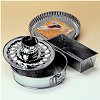|
|
|||||||||||||||
 |
|
I’ve read that strained yogurt is the same as Quark. Not true at all. It is a yogurt cheese and does not even taste like Quark. Quark contains the Lactococcus lactis bacteria, while yogurt contains Lactococcus thermophilus. Also 100g (½ cup) yogurt has a sodium level of 77mg, while Quark has only 40mg. Can I use cottage cheese instead of Quark? In some recipes you can, but remember cottage cheese has curds and a high sodium content. 100g (½ cup) of Quark has 40mg sodium and cottage cheese has 405mg! People on Dr. Johanna Budwig’s protocol or on a low sodium diet should be aware of that. See our page on nutritional information. I’ve read that I can make Quark using Rennet on the stove in a fraction of the time. Is that true? Yes, it is. That is how it is being made by the dairy industry in Germany. 4 hours and done! The downside is that you are missing the beneficial buttermilk bacteria. The German industry now adds buttermilk cultures to it due to public demand for live cultures. Using rennet on your own on the stove has another downside. The milk may become too hot and basically leaves you with cooked protein. Making it the old-fashioned way with live cultures is better for your health. I’ve read that I can make Quark on the stovetop or in the oven over several hours. Yes, you can, but it is not recommended. The most important reasons are temperature control and cost. Too much heat will cook the protein and kill all beneficial bacteria. The oven will be way to hot and you will need to leave the door open and heat the house. Now we are also talking about running the appliance over night. An oven needs about 5000 Watts per hour, while our Quark Maker only needs 18 Watts. That will go into the pocket book in the long run. |
| [What is Quark?] [Nutritional Info] [How to Make It] [FAQ] [Measurements] [Base Recipes] [Quark Recipes] [Dr. Budwig] [Other Diets] [Resources] |
|
German Corner LLC, P.O. Box 70, Keno, OR 97627, USA Phone: 541-850-0304 copyright © German Corner LLC |
 |
|||||||||||||
 |
|||||||||||||
 |
|||||||||||||
 |
|||||||||||||